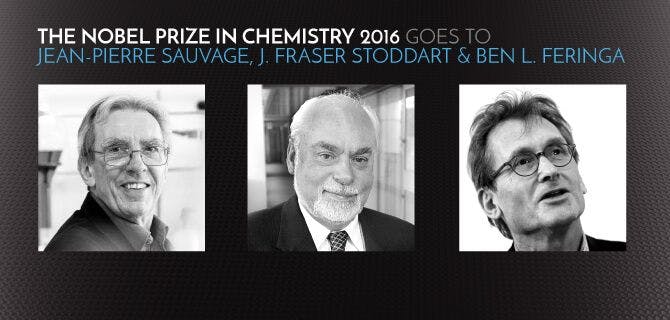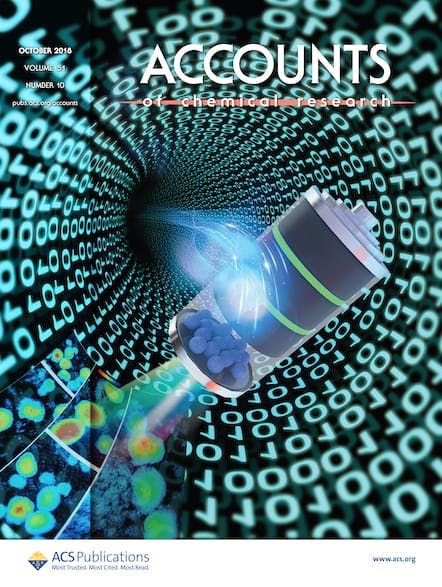The Nobel Prize in Chemistry 2016 is awarded to Jean-Pierre Sauvage, J. Fraser Stoddart, and Ben L. Feringa for their work in developing “molecular machines.” The trio, who will split the prize equally, designed and built molecules that can be controlled to accomplish a task once they’re supplied with energy. Sauvage is being recognized for his […]

The Nobel Prize in Chemistry 2016 is awarded to Jean-Pierre Sauvage, J. Fraser Stoddart, and Ben L. Feringa for their work in developing “molecular machines.” The trio, who will split the prize equally, designed and built molecules that can be controlled to accomplish a task once they’re supplied with energy.
Sauvage is being recognized for his creation of a catenane, two ring-shaped molecules linked together as a chain, since this configuration exhibits the weaker mechanical bond needed for the parts of a molecular machine to move independent of one another. Stoddart is honored for developing rotaxanes, molecular rings threaded onto molecular axles, which he used to develop molecular lifts, muscles, and computer chips. Feringa is recognized for building the first molecular motor.
Jean-Pierre Sauvage, J. Fraser Stoddart, and Ben L. Feringa all have strong ties to ACS:
- J. Fraser Stoddart has been a member of ACS for 44 years and has published 267 research articles in ACS Publications journals. He won the Arthur C. Cope Scholar Award in 1999, and then in 2008, he received the Arthur C. Cope Award. Both awards are sponsored by the Arthur C. Cope Fund. He is a member of the Editorial Advisory Board of Organic Letters.
- Ben L. Feringa has been a member of ACS for 36 years and has published 205 research articles in ACS Publications journals. He won the James Flack Norris Award in Physical Organic Chemistry in 2007, which is sponsored by the ACS Northeastern Section, and the Arthur C. Cope Scholar Award in 2015. He is a member of the Editorial Advisory Board for the Journal of the American Chemical Society, Accounts of Chemical Research, and the The Journal of Organic Chemistry.
- Jean-Pierre Sauvage has published 121 research articles in ACS Publications journals.
“ACS would like to congratulate this year’s laureates on their eloquent use of chemistry to design and develop molecular machines that can, in a controlled manner, perform a multitude of critical functions,” says American Chemical Society, President Donna J. Nelson. “While this work is in its early stages, one can envision how the fields of medicine, energy storage and materials science could be revolutionized by this discovery.”
“It’s wonderful to see Stoddart and Feringa, who have published widely in Organic Letters, being recognized by the Nobel Committee. Stoddart has performed great service to ACS Publications as a former Associate Editor of Organic Letters and continues to serve on the journal’s Editorial Advisory Board,” says Organic Letters Editor-in-Chief Amos Smith.
Read highlighted open-access research from Jean-Pierre Sauvage, J. Fraser Stoddart, and Ben L. Feringa:
Synthesis of biscopper(I) [3]-catenates: multiring interlocked coordinating systems
Jean Pierre Sauvage, Jean Weiss
J. Am. Chem. Soc., 1985, 107 (21), pp 6108–6110
DOI: 10.1021/ja00307a049
***
A molecular shuttle
Pier Lucio Anelli, Neil Spencer, J. Fraser Stoddart
J. Am. Chem. Soc., 1991, 113 (13), pp 5131–5133
DOI: 10.1021/ja00013a096
***
Synthesis of a doubly interlocked [2]-catenane
Jean Francois Nierengarten, Christiane O. Dietrich-Buchecker, Jean Pierre Sauvage
J. Am. Chem. Soc., 1994, 116 (1), pp 375–376
DOI: 10.1021/ja00080a045
***
Electrochemically Triggered Swinging of a [2]-Catenate
Aude Livoreil, Christiane O. Dietrich-Buchecker, Jean-Pierre Sauvage
J. Am. Chem. Soc., 1994, 116 (20), pp 9399–9400
DOI: 10.1021/ja00099a095
***
A Switchable Hybrid [2]-Catenane Based on Transition Metal Complexation and π-Electron Donor−Acceptor Interactions
David B. Amabilino , Christiane O. Dietrich-Buchecker , Aude Livoreil , Lluïsa Pérez-García , Jean-Pierre Sauvage , and J. Fraser Stoddart
J. Am. Chem. Soc., 1996, 118 (16), pp 3905–3913
DOI: 10.1021/ja954329+
***
Electrochemically and Photochemically Driven Ring Motions in a Disymmetrical Copper [2]-Catenate
Aude Livoreil , Jean-Pierre Sauvage , Nicola Armaroli , Vincenzo Balzani , Lucia Flamigni , and Barbara Ventura
J. Am. Chem. Soc., 1997, 119 (50), pp 12114–12124
DOI: 10.1021/ja9720826
***
Molecular-Based Electronically Switchable Tunnel Junction Devices
C. Patrick Collier, Jan O. Jeppesen, Yi Luo , Julie Perkins, Eric W. Wong, James R. Heath, and J. Fraser Stoddart
J. Am. Chem. Soc., 2001, 123 (50), pp 12632–12641
DOI: 10.1021/ja0114456
***
The Art of Building Small: From Molecular Switches to Molecular Motors
Ben L. Feringa
J. Org. Chem., 2007, 72 (18), pp 6635–6652
DOI: 10.1021/jo070394d
***
Reversible Photocontrol of Biological Systems by the Incorporation of Molecular Photoswitches
Wiktor Szymański, John M. Beierle, Hans A. V. Kistemaker, Willem A. Velema, and Ben L. Feringa
Chem. Rev., 2013, 113 (8), pp 6114–6178
DOI: 10.1021/cr300179f
***
Asymmetric Synthesis of First Generation Molecular Motors
Thomas M. Neubauer, Thomas van Leeuwen, Depeng Zhao, Anouk S. Lubbe, Jos C. M. Kistemaker, and Ben L. Feringa
Org. Lett., 2014, 16 (16), pp 4220–4223
DOI: 10.1021/ol501925f
***
Allosteric Regulation of the Rotational Speed in a Light-Driven Molecular Motor
Adele Faulkner, Thomas van Leeuwen, Ben L. Feringa, and Sander J. Wezenberg
J. Am. Chem. Soc., Article ASAP
DOI: 10.1021/jacs.6b06467
***
Read more about the research of Jean-Pierre Sauvage, J. Fraser Stoddart, and Ben L. Feringa and the 2016 Nobel Prize in C&EN.
Want the latest stories delivered to your inbox each month?

Accounts of Chemical Research
Read our latest issue. Want to contribute to this journal?